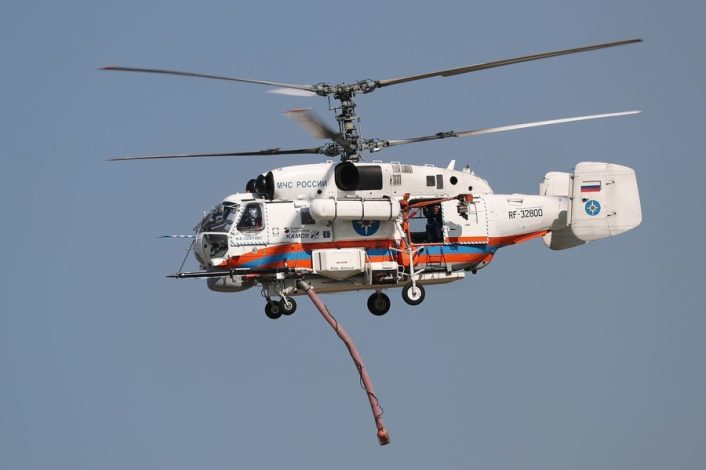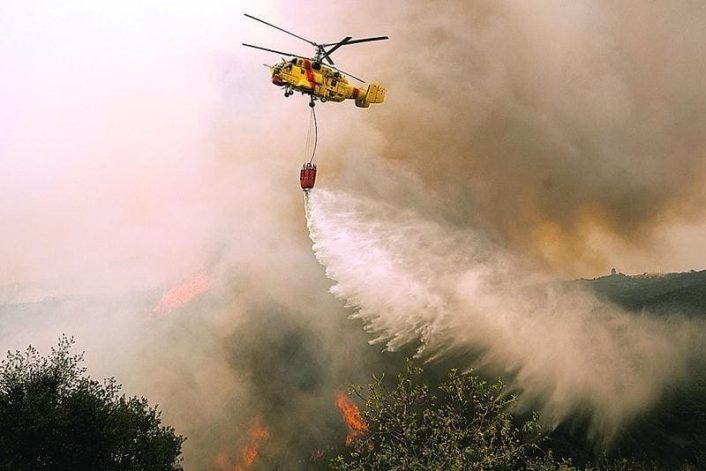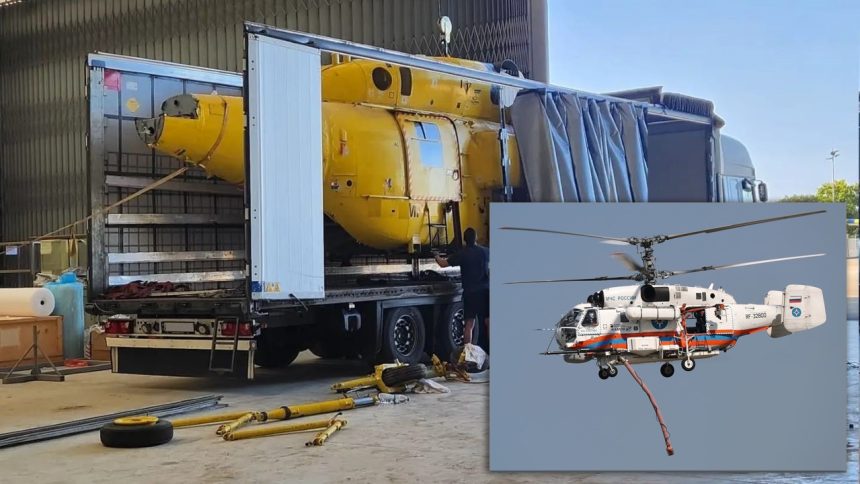After two years, Ukraine will finally receive the six Ka-32A11BC helicopters previously used by Portugal, although reports do not specify if the helicopters will fly again or will be cannibalized for spares.
Nearly two years after Portugal announced in October 2022 the intention to send to Ukraine the six Russian Kamov Ka-32A11BC firefighting helicopters in its fleet that were “inoperable,” the choppers were finally sent to Kyiv.
Acquired in 2006-07 for around $350 million by the Ministry of Internal Affairs, these helicopters were not operable owing to sanctions, as a Russian maintenance team from Kamov was expelled and a maintenance center in Ponte de Sôr was shut down following Russia’s attack on Ukraine. Another Ka-32 was “inoperative after having suffered an accident,” Sic Noticias reported.
Reports do not specify if the helicopters will be flown by Ukraine or cannibalized for spares, but the latter is highly likely. Reports from Sep. 2021 quoted the then commander of the Ukrainian Navy, Rear Admiral Oleksiy Neizhpapa, saying the “main task” of the Marine Aviation Brigade was to replace the Ka-27PL and the Ka-29 (that was retired much earlier) with a “Western-type.” The Ka-27PL was used for ASW (Anti-Submarine Warfare) roles.
⚡️It is reported that the transfer of 6 Kamov Ka-32A transport helicopters donated by 🇵🇹Portugal to 🇺🇦Ukraine has been completed,- Sic Noticias pic.twitter.com/6GwNhdTXEP
— 🪖MilitaryNewsUA🇺🇦 (@front_ukrainian) September 7, 2024
The Portuguese Ministry of Defense Nuno Melo acknowledged that the “last truck with Kamov material bound for Ukraine” left the maintenance center in Ponte de Sôr. Pictures released by the defense ministry showed one of the disassembled helicopters being loaded on the back of a truck’s trailer.
Finally sent to Ukraine
In Nov. 2023, more than a year after the announcement of the transfer to Ukraine, the aircraft were still in Portugal, as the government was waiting for the “Ukrainian counterpart to indicate the next steps to be taken” in this process.
“After a long period of uncertainty and negotiations, the current government, through the MDN, in conjunction with the Ministry of Internal Affairs, coordinated the transport of the helicopters with the Ukrainian authorities, in particular with the Ukrainian Embassy in Lisbon and with the Ukrainian Ministry of Defense,” a Portuguese defense statement said.
The lack of spares and maintainability led to the absence of an airworthiness certificate from Portugal’s aviation regulator, relegating the units to the hangar. After Ukraine sought these helicopters, it was decided they “would be donated in the state of conservation in which they were found.”

Quoting reports from Portugal, Scramble in September 2022, said that these six Ka-32A11BCs that were operated by the state-owned Empresa de Meios Aeros, S.A. were being replaced by the Sikorsky UH-60A Blackhawks. Following an accident, the helicopter with serial number CS-HMO 9905 was written off on Sep. 3, 2012. The remaining ones were not in an airworthy condition since early 2022, following the expulsion of the Russian maintenance team.
Ka-32A
Kamov introduced the basic Ka-32A model in 1986 as a medium-sized helicopter and a civilian version of the military Ka-27PS, which was based on the older Ka-25 and Ka-27. Its development began in 1969 and the maiden flight of the first prototype took place in 1973. The first operational Ka-32 first flew in Oct. 1980 and was internationally unveiled for the first time at the Paris Air Show in 1985.
It was originally intended for reconnaissance flights over the Arctic, when the Ka-32A enhancement evolved to undertake search and rescue, emergency missions, transport cargo, and support allies at sea. This variant flew for the first time in 1990.
Interestingly, the Russian Navy uses the Ka-27 Helix extensively, and the helicopter has been used to destroy Ukraine kamikaze USVs (Unmanned Surface Vessels) assigned to its Black Sea Fleet. The Indian Navy’s Ka-31 helicopter operating from the Russian-origin aircraft carrier INS Vikramaditya, also has its airframe based on the Ka-27. The former is distinguished by its large rotating radar array on the underbelly, as the helicopter is used for AEW (Airborne Early Warning) roles.
⚡️Additional photo of the transportation of the 🇵🇹Portuguese Ka-32A11BC in a truck for further transfer to 🇺🇦Ukraine https://t.co/Nz4uNjngiW pic.twitter.com/H6wCEdSDwC
— 🪖MilitaryNewsUA🇺🇦 (@front_ukrainian) September 8, 2024
According to Aerospace Technology, “special variants” like the Ka-32A1 and then the Ka-32A11BC (the version being transferred from Portugal to Ukraine) were developed for emergency and firefighting roles. The Ka-32A2 was meant for policing and law enforcement roles. The basic Ka-32A can carry 13 passengers inside or haul a payload of up to 5 tons on an external sling.
The helicopter is 41 feet in length and 18 feet tall in height, with the diameter of its main three-bladed rotors 52 feet. These are made of composite materials and can be folded for compact storage. The helicopter is powered by two Klimov TV3-117VMA engines and can reach speeds of 259 km/h, with a maximum range of 799 km.
The helicopter has specialized equipment like emergency landing tools and a range of radar and navigation avionics and kinematic performance enhancement systems. These include a DHI (Doppler Hover Indicator), two HSI (Horizontal Situation Indicators), a doppler box, radar altimeter, ADC (Air Data Computer) and a three-axis autopilot offering automated approach at an altitude of 25 meters from the ground.

Ka-32A11BC
The Ka-32A11BC version is a dedicated SAR (Search and Rescue) aircraft, patrol, medical evacuation, cargo transport, logging and fire-fighting. The fire-fighting variant was unveiled during the Dubai Helishow in 2014. It has a four-wheel type landing gear for operating off small vessels, drilling platforms and unprepared areas. It can be operated by a single pilot and has a standard MTOW (Maximum Take-Off Weight) of 11,000 kg.
The fire-fighting version can be attached with both horizontal and vertical fire-fighting equipment, including Bambi-Bucket and Simplex systems, and water cannon. A medical module can be installed in the MEDEVAC variant. Beside equipment for flight in poor visibility, inclement weather conditions and day-night operations, it can accept advanced surveillance, tracking and loudhailer communications.
Le Portugal transfère des Kamov Ka-32A1 à l’Ukraine, promis fin 2022.
Le Ka-32 est une version civile du Ka-27 utilisé par beaucoup de marines de l’ex-URSS, dont celle de l’Ukraine.
Les appareils sont équipés pour la lutte contre les incendies et ne volaient plus depuis 2018. https://t.co/xNMVFHeBc2 pic.twitter.com/KmfPA3gx91
— Aurélien Morel (@DefenseJokes) September 7, 2024
At least seven Ka-32A11BCs are in service with Russia’s EMERCOM (Emergency Management and Natural Disasters Response) since May 2011. These are also in service with Kazakhstan, Belarus and China.









